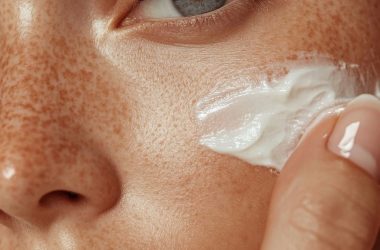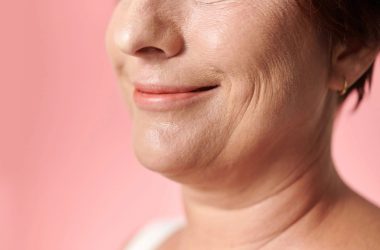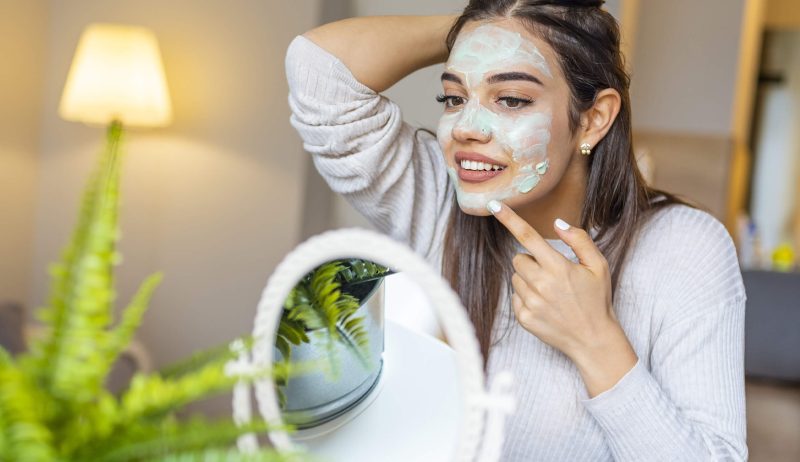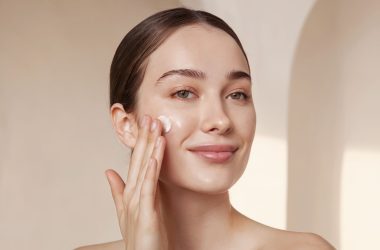Separating fact from fiction when it comes to battling acne blemishes
Posted on August 22, 2024 Written by: 100% PURE ®

Acne can feel like the arch enemy of healthy skin. When we get an acne blemish, we take desperate measures – using bizarre treatments and making rash decisions to get rid of it. This pimple psychoanalysis may include dabbing Windex on the bump or experimenting with age old extraction remedies – but please, do NOT put Windex on your pimple.
Roughly 80 percent of people are affected by the pimple plague at some point in their lives. With how regularly pimples appear, it’s no wonder we’re faced with more myths and treatments ideologies than we can handle. We’re decoding the most common acne myths, and revealing DIY acne blemish treatments that can actually work for clearer skin – without the scary side effects!
Need help navigating the dangerous world of pimple-purging? For each acne treatment myth we’ll provide one tried and true DIY remedy to help get your skin back on track.

You know that annoying buzzer and big, orange ‘X’ when the answer is wrong on Family Feud? That’s what you should be hearing in your head. Please don’t put something meant for your teeth on your acne blemish – thanks for playing!
Toothpaste is a potent, plague-removing, and whitening wonder to be sure – but it isn’t designed for your skin. “You shouldn’t be putting something like that on your delicate skin – you’ll irritate it,” says Dr. Rachel Nazarian of the Schweiger Dermatology Group.
DIY ACV Acne Spot Treatment
Organic apple cider vinegar, water, cotton balls
Instead of using toothpaste, applying diluted apple cider vinegar onto a breakout can actually have some serious anti-acne effects. The organic acids in ACV help kill acne-causing bacteria, reduce inflammation, and minimize the appearance of scars.
Step 1: Mix 1 part apple cider vinegar and 3 parts water.
Step 2: Gently cleanse your face with a natural cleanser to clear surface debris. Our Pore Detox Herbal Cleanser gently detoxifies the skin while unclogging pores and reducing the appearance of pores.
Step 3: After cleansing, gently apply ACV mixture to skin using a cotton ball. Let sit on acne blemish for 1-2 minutes, then rinse with water and pat dry.
We’re probably all guilty of this, and of popping pimples. It’s hard to resist when it looks like there’s dirt speckled on our face in the form of blackheads, or an acne blemish that’s taken on a personality of its own. Blackheads are caused when a clogged pore becomes exposed to air, which becomes oxidized and turns dark or black – hence the term “blackhead”.
Please refrain from squeezing those pesky blackheads and cyclops pimples. Using your index fingers and leaving fingernail indentations behind is bad for business. If you’re not careful, broken capillaries or scars could become your new constant companion.
DIY Blackhead Scrub
Dry oatmeal, baking soda, lemon juice, bowl, towel
You can mix up an easy, home remedy for a gentle scrub or spot treatment. It’s great for exfoliating and keeping excess oil at bay for clearer pores and a brighter complexion.
Step 1: Start with clean, dry skin. (This would be the perfect time to give yourself a steam facial).
Step 2: Pour 1/4 cup oatmeal and 1tsp baking soda into a mixing bowl, then add 1tbsp fresh lemon juice.
Step 3: Mix ingredients into a paste. If your scrub is on the dryer side, add more lemon juice; if it ends up too watery, add oatmeal until it’s pastier.
Step 4: Scrub-a-dub time. Apply the mixture to damp skin, and work it in for about a minute. Use gentle, circular motions and focus on areas that are prone to blackheads like the nose and chin. Rinse and pat dry.

Ice, ice, baby – all right stop, collaborate and listen: using ice for inflammation is not a groundbreaking strategy. Since the 70’s and the introduction of groovy but crazy roller skating maneuvers, people often ended up with injuries. That’s when the ice, RICE, baby technique came around.
RICE – rest, ice, compression and elevation – is used to reduce pain and inflammation. Ice can soothe redness and reduce inflammation of an acne blemish. When you apply ice, it constricts the blood vessels and reduces inflammation.
DIY Ice Pack and Cube Infusion
Pre-made ice or empty ice tray, towel or cotton cloth, lemon juice or green tea (optional)
An infused ice pack wrapped in cloth is far gentler on your skin than direct contact with an ice cube. Don’t apply ice directly to your skin and acne blemish – you could end up with an ice burn or harsh sticking and peeling if your skin is dry.
Step 1: Make an ice pack by wrapping the ice cubes in a small towel, or put them inside a sandwich bag protected by a towel.
Step 2: Gently hold your cold compress against the affected area for about 5-10 minutes. Take a break for 3-4 minutes, and then reapply for 5-10 more minutes.
Step 3: You can also make infusion ice cubes by freezing water with a 50:50 ratio of lemon juice or green tea, and rubbing the cubes on your affected areas. These ingredients have great anti-inflammatory and skin-soothing properties.
We get it – most oily skin types want to run from facial oil like they do a bad ex. That’s mostly due in part to the myths circulating that putting oil on your face will make it oilier and more prone to breakouts. Cue the Family Feud buzzer!
For oily skin types, breakouts, acne, and even more oil happen when we dry our skin out by skipping moisturizer or using harsh ingredients that strip our skin. If the skin is deprived of natural oils, it will make more oil to compensate, which can lead to breakouts.
Facial oils can help replenish your natural oils, keeping levels balanced and breakouts at bay. They also provide anti-inflammatory and antibacterial benefits, which can help reduce the redness and sensitivity of acne.
Oily Skin DIY Face Oil
Jojoba oil, tea tree oil, glass bottle
Step 1: Mix 30 mls of jojoba oil (or another non-comedogenic carrier oil) and 2-3 drops of tea tree oil. Jojoba oil is amazing at controlling oil production while replenishing moisture. The antibacterial properties of tea tree oil ward off acne-causing bacteria. And if you want to make it a fixture in your routine, you can find it as a key ingredient in our Tea Tree Balancing Moisturizer and our Tea Tree Deep Detox Mask.
Step 2: Apply 3-5 drops of the mixture to your palms, rubbing your hands together to warm up the oil. Gently pat the oil onto your face until the oil is absorbed. Store in an amber or dark colored glass bottle, in a cool dry place.
If you’ve ever used rubbing alcohol on your face in a teenage moment of desperation, you’re not alone. You’re old enough to know now that the same ingredient that can disinfect a toilet surely has no place on your delicate face!
Alcohol removes the oil from your skin – and then some! It will strip your epidermis of natural lipids, signaling your skin to produce more oil to compensate. Before you know it, you’ll end up with even more acne blemishes.
There are far gentler, more effective options in store for you, especially when you get back to the basics. A good cleansing, for instance, will go a long way–especially when you use a cleanser with ingredients that target acne troubles like our Tea Tree & Willow Clarifying Cleanser. Meanwhile, a good vitamin C serum will not only help fade acne scars, but support overall skin health!
Additionally, instead of stripping skin with an alcohol-based toner, apply a natural astringent that’s formulated to be gentle on acne-prone skin. This DIY astringent contains witch hazel, which is capable of naturally reducing acne. It’s strong antioxidant and astringent properties are perfect for killing bacteria that live within the skin’s pores.
DIY Acne Astringent
Witch hazel, tea tree oil, distilled water, glass bottle
Step 1: Mix 1/4 cup witch hazel and 2-3 drops of tea tree essential oil. You can also use marula or green tea oil.
Step 2: Pour into a glass bottle and fill the rest of the way with 1 cup of distilled water. Mix well.
Step 3: Dispense toner onto a cotton pad and apply all over skin in gentle strokes that move up and out from the center of the face.
Want more details on caring for acne and what could be causing it? Find out common causes of breakouts and what you can do about it. Don’t forget to ditch those acne myths and go with the ones that work! Be sure to spread the news to put an end to this myth madness!
Frequently Asked Questions About Acne Treatments
What are the most common myths about acne treatments?
Myth: “Acne is caused by poor hygiene.”
Fact: While cleanliness is important, acne is primarily caused by factors like genetics, hormones, and bacteria, not by poor hygiene.
Myth: “Tanning clears up acne.”
Fact: Sun exposure might temporarily dry out acne, but it can also damage the skin and lead to more breakouts later. Plus, UV exposure increases the risk of skin cancer.
Myth: “Only teenagers get acne.”
Fact: Acne can affect people of all ages, including adults in their 30s, 40s, and beyond, due to hormonal changes, stress, and other factors.
Myth: “You can clear up acne overnight.”
Fact: Acne treatments take time to work, and there’s no instant cure. Consistent skincare and patience are key.
Is toothpaste an effective spot treatment for acne?
No, toothpaste is not an effective or recommended treatment for acne. While toothpaste contains ingredients like baking soda, hydrogen peroxide, or alcohol that may dry out a pimple, it can also irritate the skin, causing redness, peeling, or even worsening the acne. It’s better to use products specifically formulated to treat acne.
Can squeezing blackheads help get rid of them?
Squeezing blackheads is not recommended and can do more harm than good. It may push bacteria and debris deeper into the skin, leading to more breakouts, inflammation, and even scarring. Instead, using a gentle exfoliant or a product with salicylic acid can help to unclog pores and reduce blackheads over time.
How effective is ice in reducing acne inflammation?
Ice can be effective in temporarily reducing the redness and swelling of an inflamed pimple. It works by constricting blood vessels and reducing blood flow to the area, which can minimize inflammation. However, ice won’t treat the underlying causes of acne, so it should be used as a complementary treatment rather than a primary one.
Should people with oily skin avoid using facial oils?
Not necessarily. While it might seem counterintuitive, some facial oils can actually help balance oily skin and prevent it from producing excess sebum. Oils like jojoba, squalane, and rosehip are lightweight and non-comedogenic, meaning they won’t clog pores. These oils can help to moisturize the skin without causing breakouts, but it’s essential to choose the right type of oil and use it sparingly.









